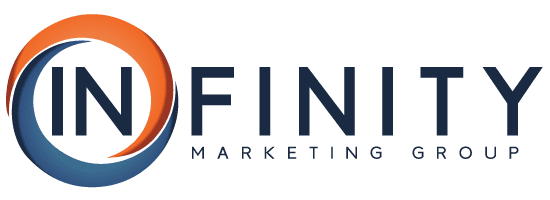When I was a kid, my mother taught me how to reuse or repurpose the things we had instead of just always buying something new.
For example, instead of buying shoe cleaner for my white sneakers, I could clean them with an old toothbrush and toothpaste (seriously try it, it works).
Not only did this practice save us money, but it helped teach me about the worth of things. It can be so easy to fall into the disposable cycle of our modern world. But most things have a much longer and versatile life in them than we give them credit for.
And the same type of thinking can be applied to marketing too.
Marketing materials, strategies, and products shouldn’t be viewed with the one-and-done mindset, and there are so many ways you can use one aspect of your marketing to help several different strategies.
For example, instead of spending a ton of money testing out a new target audience on a Facebook Ad campaign, try using your existing email list to retarget your ads to. This utilizes your existing prospect or customer base. That way you will build authority, refresh interest with your product or service, and create opportunities for those who already love what you do to share your business.
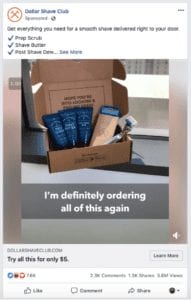
And doing this is easy. All you have to do is use the Facebook Business Manager to upload your current email list and create Custom Audiences that you can then show your ads to exclusively. This creates an extremely warm, targeted audience for your campaigns which can be a total goldmine for paid advertising ROI.
Here are the steps to do this:
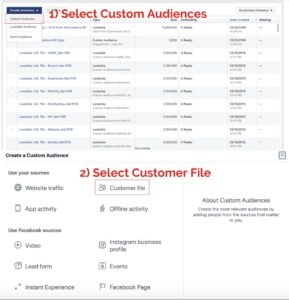
In Facebook Business Manager, just select create a custom audience, and then select Customer File as the source.
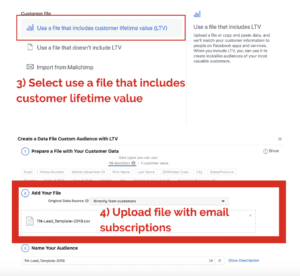
Then you want to use a file that includes the customer lifetime value (LTV). From there you will add your file of email subscribers.
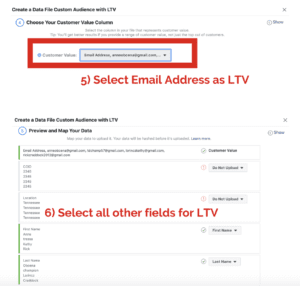
For the customer value column, you will want to select email address as the LTV, and then select all other fields as well for LTV under Preview and Map Your Data.
And then you are all set!
The way it works, in a nutshell, is, when you upload the email list, Facebook will search for all of the user profiles that match the emails in your list. And if you’re wondering what percentage of your list will match Facebook profiles, well that can differ from list to list depending on certain factors: where you got the list, if they’re personal or business emails, etc.
But to give you a ballpark range, my email lists typically come back with 80% or more matches—and this is a pretty standard number.
Now, you may be asking yourself: “Why in the world would I want to spend money to target people I’m already reaching with my emails?” Here’s a few reasons why this is a huge advantage to standing out in your industry:
#1. Connect with people in a more relaxed setting
Most of us get emails while we’re at work, and there are so many that we don’t have time to read them all. Those who open your emails may scan it and star or save with the intention of going back later to click through to your site. But people are people. We forget things sometimes.
And since email is mostly work-related, it’s not really designed for massive engagement. Facebook, however, is perfect for that. People typically browse their feed in the morning, at lunch and in the evening while in front of the TV. It is a go-to for scrolling while they’re waiting for something to happen (think parents at soccer practice or waiting for the train) and when they have some free time.
Since your audience saw your email earlier in the day or week, they’ll be more likely to remember you when they see your Facebook ad pop up in their feed. It might even remind them to go back and open up that email to take action on your offer.
TIP: Make sure that your message in the ad is the same, or very similar, to the message in your emails. This makes sure your customers know who you are and is already primed to follow through.
#2 Always be in front of those you want to connect with
On average, marketing messages need to be seen by prospective buyers multiple times before they’ll decide to take action—this is known as the “rule of seven,” a term coined by Dr. Jeffrey Lant.
Since the average tech-related shopper uses more than 14 sources of information to arrive at their decision to buy, you want to be seen on multiple platforms.
Using email AND Facebook advertising helps increase the frequency that they see you; so not only will they notice you, but they will (hopefully) remember you when they are making a purchase decision. That’s where the sweet spot is!
#3 Your company will seem large and your reach broad
There’s a funny thing that happens when people see your business marketing in multiple social channels: it looks like your business is everywhere. Although you might not get a lot of traffic to your business’s Facebook page, people these days expect that you have one, and that you are active on the platform.
Additionally, with good retargeting ads popping up all over the place, many people will assume you must be spending a lot of marketing dollars to reach them. This makes it look like your business is large and/or very successful, since you have the time, manpower, and money for so many ads. They might also assume that everyone, not just themselves, is seeing these ads, since Facebook is such a big advertising space.
All of these assumptions help to build your authority.
But guess what… you don’t have to spend tons of money to get this kind of reach online. For just a few dollars a day, you can reach your entire email list daily on Facebook. Not bad right?
When your business looks larger, you’ll also build trust with your customers (potential AND current), since you are there ready to give them the information they want and are showing them products they already like (assuming they are already familiar with your products).
#4 Look-alike audiences are amazing for reach
But the benefits don’t end with just engaging your current audience. Part of the beauty of this strategy is that you can connect to thousands of people who have similar interests, demographics, purchasing habits, and online activity as your current customers.
After uploading your email list to Facebook and creating that first Custom Audience to target, you can also create a “look-alike audience”. A look-alike audience is comprised of other Facebook users that have similar interests and needs to your current audience.
This is one of the most powerful tools in digital marketing today. This is one of the easiest ways to reach new people, particularly if you have a strong, engaged customer base in your email list.
It’s obviously great to retarget your current followers, but having the ability to expand your audience based on that specific demographic could be the difference between doubling or tripling your ROI.
Now that you have all the information, and reasoning, on retargeting your email list, it’s time to take action. Upload your list and launch a Facebook campaign that mirrors your next email. If you can get even 20% more ROI from the campaign as a result, then that’s a big win. But don’t be surprised if it’s much higher. And if it is, you can buy me a beer as a thanks. I’m a cheap date.
—

J.C. Granger is the CEO of Infinity Marketing Group. Infinity Marketing Group is an inbound marketing agency headquartered in Denver, Colorado that specializes in helping SaaS companies achieve their lead generation goals.
Connect with J.C. on LinkedIn and download his free eBook, “3 Essentials of Inbound Marketing”.
